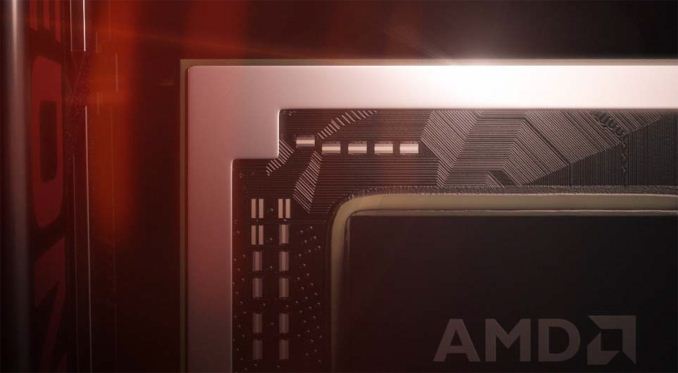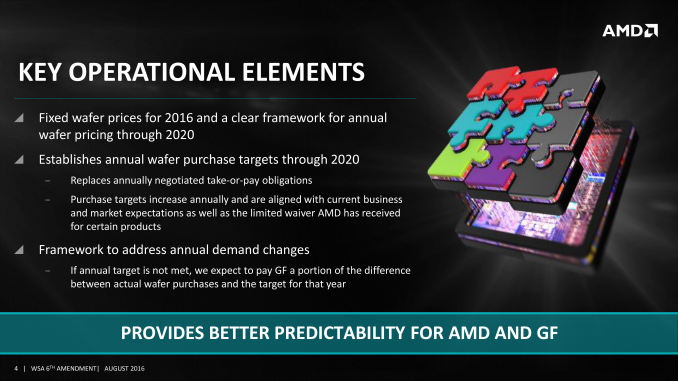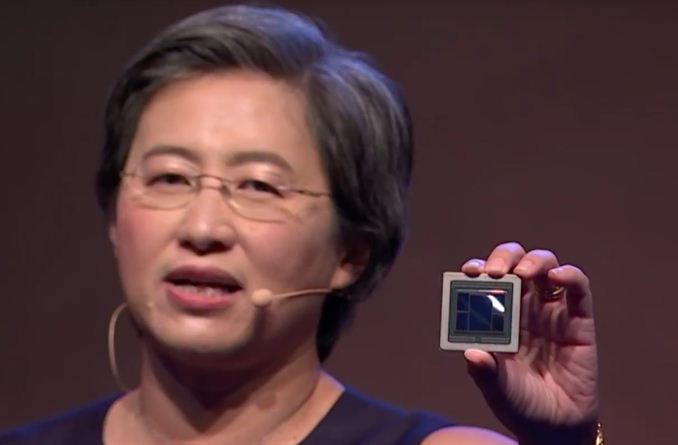AMD's 7nm CPUs & GPUs To Be Fabbed by TSMC, on Track for 2018 - 2019
by Ryan Smith & Anton Shilov on August 27, 2018 6:40 PM EST- Posted in
- Semiconductors
- CPUs
- AMD
- GlobalFoundries
- GPUs
- TSMC
- Vega
- Navi
- Zen 2

With the announcement that its long-time manufacturing partner (and outright former fab) GlobalFoundries is dropping out of the race for bleeding-edge manufacturing nodes, the second big question of the day has been what this means for AMD. For all intents and purposes, AMD and GlobalFoundries have been tied at the hip since GloFo was spun off from AMD back in 2009, and consequently GloFo has always been AMD’s fab of choice for CPUs, and more recently GPUs. So with GlobalFoundries’ changes to their process development plans, AMD is outlining their new partnerships and manufacturing plans.
In short, AMD is now shifting over the bulk of their bleeding-edge development to TSMC. The company is careful to note that they “intend to focus the breadth” of their 7nm production at TSMC rather than all 7nm production – leaving open the possibility of using TSMC rival Samsung in the future – but the message is clear that we should expect AMD’s major 7nm products to be fabbed out of TSMC now that GlobalFoundries is no longer an option.
TSMC being AMD’s new bleeding-edge partner should of course come as no surprise, as TSMC has been the fab AMD has fallen back on for other projects in the past. TSMC was until the most recent generation the fab AMD used for their GPUs, and it’s where their semi-custom APUs for Microsoft and Sony have been made. Meanwhile AMD and TSMC have already previously announced that some of AMD’s forthcoming 7nm products, including their 7nm Vega and “Rome” EPYC CPU would be fabbed by the Taiwanese foundry. So today’s announcement is largely confirmation that AMD is going to continue down this path, with most (if not all) of their other planned 7nm products ending up at TSMC as well.
As it stands then, AMD’s plans remain largely unchanged. AMD’s 7nm Vega GPU has been successfully taped out, and it is currently sampling among AMD’s customers with a commercial launch towards the end of this year. Then in 2019, AMD intends to release its CPUs featuring its Zen 2 microarchitecture. These processors will also be fabbed by TSMC and the chip designer has already received the first working silicon.
Farther out, AMD’s announcement also confirms that their upcoming Navi architecture GPUs, which are also planned for 7nm, will be fabbed at TSMC. Though AMD has not disclosed any timeframes regarding these GPUs and whether any of them have been taped out.
Overall, AMD seems reasonably happy with the current state of affairs, stating that “Our work with TSMC on their 7nm node has gone very well and we have seen excellent results from early silicon.” As a close GlobalFoundries customer, I have to imagine that AMD was the first such customer informed of these plans, so they’ve had the most time to adjust their internal plans. None the less, the company sees it as win for their “flexible foundry” strategy, and as a result, they do not expect any changes to their product roadmaps despite the foundry changes.
That said, while AMD seems to be handling this well, this isn’t a feint on their part, and that they’ve had to make changes behind the scenes. The company has confirmed to us that they had started development of a chip to be made using GlobalFoundries' 7LP process technology, but this one had not been taped out yet (it was on track for a Q4 tape out, according to GF). So we will be seeing products that weren’t originally intended for TSMC.
As for AMD’s GlobalFoundries relationship, the company will be continuing to work with GlobalFoundries for some time to come. GloFo is still AMD’s fab for their current Vega, Polaris, and Zen/Zen+ chips, and AMD will continue making chips there. Furthermore should AMD decide to start on any new chips that don’t require a bleeding-edge manufacturing process (e.g. a chipset), then GlobalFoundries is still an option.

To be renegotiated: AMD's most recent GF Wafer Share Agreement
The biggest remaining question then will be what this means for AMD and GlobalFoundries longstanding Wafer Share Agreement (WSA), which has kept the two companies bound together tightly and required that AMD do most of its manufacturing at their former fab. Today’s announcement from GlobalFoundries and AMD has confirmed that the two companies will be renegotiating the WSA – presumably a requirement should GloFo no longer intend to offer bleeding-edge nodes – though to what extent remains to be seen. AMD by their own admittance is betting very heavily on 7nm products, so it’s not clear whether the company is going to need all that many wafers from GlobalFoundries in a couple years’ time. In the meantime, AMD does not believe it is going to need any WSA with TSMC.
Related Reading:
- GlobalFoundries Stops All 7nm Development: Opts To Focus on Specialized Processes
- AMD “Rome” EPYC CPUs to Be Fabbed By TSMC
- AMD Demos 7nm Vega GPU: Betting Big on Machine Learning for Radeon Instinct; Shipping This Year
- The AMD Threadripper 2990WX 32-Core and 2950X 16-Core Review
- More Details About the ZhongShan Subor Z+ Console, with Custom AMD Ryzen SoC
- The AMD 2nd Gen Ryzen Deep Dive: The 2700X, 2700, 2600X, and 2600 Tested
Source: AMD











28 Comments
View All Comments
Drumsticks - Monday, August 27, 2018 - link
Feels like a pretty big deal. Maybe some short term disruption to AMD, but surely that's a good move overall? The WSA seems certainly more limiting to AMD - if they need high performance products it seems hard to say that they've always been better off on GF.It'll be interesting to see what happens to GCN moving back to TSMC as well. It certainly wont account for the entire performance difference, but the TSMC finfet processes have all been measurably better than the 14nm process that Glofo licensed, right?
Dragonstongue - Monday, August 27, 2018 - link
IMO hard to say if the difference of TSMC 16nm vs GF14nm was "measurably better" because my understanding is there was not a single product made on both of them by the same company making the product using a specific chip "tooled" for both of them (example...GTX 1050 Ti at TSMC AND GF to see the real difference)The only way to know for sure for sure would be to get 2 more or less equal produces (as far as spec were to be concerned) and compared them directly as far as the speed they could achieve, power they use, heat they push out and so forth.
way back in the day they did this with vehicle engines same spec at different plants and you WANTED from plant X not plant Y because it was that much better...
I dream of the day we are able to "unhook" a portion of the chip (like a lego block) so when you absolutely do not need the power, unhook it completely, or, add a block on...like HBM but more substantial, kind of surprised they have not done this, easy to add performance or remove performance while knowing exactly what that block would be capable of (for the maker of it)
I know internally Intel, Ngreedia and the like do this (by enabling or disabling features by "clipping" the die) would be kind of nice in a way though cause they could sell a "base core" and the end user who has extra coin can make it a "beast core" ^.^
close - Tuesday, August 28, 2018 - link
Letting you "add" to such a highly integrated circuit doesn't make sense technically or financially. It's far cheaper to build the full chip and deactivate the defective units (or even fully functioning ones) than it is to build dozens of completely different SKUs that can later be combined somehow.So I'm reasonably sure that when it comes to chips you'll get less flexibility in the future, not more. If we're lucky they won't move exclusively to HBM and have to upgrade the CPU for more RAM. :)
Targon - Wednesday, August 29, 2018 - link
Gen-Z has some potential in that area, or even Infinity Fabric. Something like the old school idea of 2+ CPU systems, or co-processors being in the system. The problem these days is that CPU performance is tied very closely to how quickly different components within a CPU can talk to each other, so going to another physical "chip" would cause a huge performance hit. We can't even get video cards where we can upgrade the video memory by there being sockets/slots on the card at this point, which would free video card makers from being caught between higher memory prices and a MSRP.CajunArson - Monday, August 27, 2018 - link
This announcement cleverly states nothing while making people who weren't paying attention think that AMD knew about GloFo never producing 7nm all along... you know, like when Cutress ran around GloFo's fab in that bunny suit not too long ago.AMD was *always* going to produce its expensive high-end parts at TSMC and this has been known for a long time.
What was also known was that desktop RyZen 2 and the APUs that actually make up the bulk of AMD's sales were supposed to be made at GloFo because GloFo was supposed to be *cheaper*.
Well guess what: The cheaper option is out the door, and unlike GloFo, TSMC is not an incompetently run charity that exists to give a third-tier player like AMD steep discounts when the big boys will pay real money for 7nm capacity.
Mark my words, there *will* be an impact on consumer chips over this even if some low-clocked server parts launch next June.
enzotiger - Monday, August 27, 2018 - link
I don't get it when AMD said this has no impact on their deliveries. GPU and EPYC were targeting TSMC's 7nm and thus they are fine. But what about Zen2 based consumer CPU/APU? It depends on when AMD was informed of this change, we might not see those CPU/APU in 2019.Valantar - Tuesday, August 28, 2018 - link
Has there been any indication that Zen2 CPUs won't be based on the same dice as Zen2 Epyc (and thus fabbed by the same company)? If so, that would be a noteworthy change. I wouldn't be surprised if 3000-series APUs are delayed or otherwise changed, though.Targon - Wednesday, August 29, 2018 - link
It was actually planned that both TSMC and Global Foundries would BOTH be making Ryzen third gen processors, because the 7nm equipment used by both were similar enough to allow it(for the first time in ages). I suspect that poor management at Global is to blame for their problems while TSMC was able to get things working.ghostbit - Monday, August 27, 2018 - link
Meh, GF PDKs aren't that good anyways.lefty2 - Tuesday, August 28, 2018 - link
All products were to switch to 7nm by 2020, so there's no longer any need for 14nm/12nm. That means they'll have to make a huge payment to get out of the WSA.